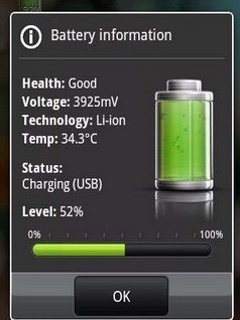iPhone outsells all other smartphones in the United States combined, but Android is faring better on a global scale. So will Apple’s carefully crafted combination of iOS and in-house hardware rule out in the end, or will Google and Samsung’s model of flooding the market with a variety of hardware models running Android win out? The answer will have less to do with which business model is more viable and more to do with which vendor makes the next major breakthrough in battery technology. Regardless of platform or device, the one thing smartphone users all have in common is that they have to meter their own usage during the day so that the battery isn’t dead by sundown. That’s because smartphone vendors are all still relying on lithium ion batteries. Despite various minor breakthroughs on how the mobile devices consume their lithium ion battery power, there’s no getting around the laws of physics which says that a certain amount of juice has a certain amount of size and weight to it.
 A generation ago, when there weren’t yet smartphones, early laptop computers ran on Nickel Cadmium batteries. Those were the type which developed “memory” if you left them on the laptop charger for too long, and had other limitations which made them comparatively primitive to lithium ion laptop batteries. But what made Li-ion such an advancement over Nickel Cadmium is that the same amount of juice could be gotten from a battery which was thinner and lighter. Laptops got thinner and lighter while offering more hours of battery life. Devices like the MP3, iPod, whose batteries had to be small enough to keep the device no bigger than the size of the user’s hand, were able to debut with realistic battery life. But unlike laptops which are typically only used at Point A or Point B, or iPods which are typically only used for a single function with the screen turned off most of the time, smartphones are natural born battery hogs, requiring a new battery technology if users are to be able to get through the day without having to worry about preserving enough NOKIA 3310 Mobile Phone Battery power to make one last phone calling.
A generation ago, when there weren’t yet smartphones, early laptop computers ran on Nickel Cadmium batteries. Those were the type which developed “memory” if you left them on the laptop charger for too long, and had other limitations which made them comparatively primitive to lithium ion laptop batteries. But what made Li-ion such an advancement over Nickel Cadmium is that the same amount of juice could be gotten from a battery which was thinner and lighter. Laptops got thinner and lighter while offering more hours of battery life. Devices like the MP3, iPod, whose batteries had to be small enough to keep the device no bigger than the size of the user’s hand, were able to debut with realistic battery life. But unlike laptops which are typically only used at Point A or Point B, or iPods which are typically only used for a single function with the screen turned off most of the time, smartphones are natural born battery hogs, requiring a new battery technology if users are to be able to get through the day without having to worry about preserving enough NOKIA 3310 Mobile Phone Battery power to make one last phone calling.
Most smartphone usage comes with the screen turned on, which is an exorbitant cell phone battery drain. Smartphones also tend to have two to three different kinds of wireless networking turned on at any given time, from cellular to Wi-Fi to Bluetooth, which is also a heavy drain – particularly when it can’t find a signal. Throw in the overwhelming battery drain caused by video game apps, and it adds up to a recipe where USB battery bricks and “battery cases” are more common than users wish they were. Tablet PCs face the same usage strains, but because they’re significantly larger than smartphones, they have room for a much larger HP hstnn-ob89 extended life battery. Teardowns of some popular tablets reveal that the majority of their internal space is occupied by an oversized battery. Smartphones can’t house batteries as large, and are therefore more prone to coming up short of user battery life expectations. Whether it be Apple or Google or Samsung or some other player the first company to offer a normal sized smartphone with fifty hours of screen-turned-on battery life is likely to win the smartphone battle.

